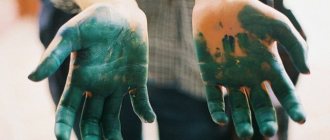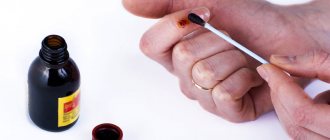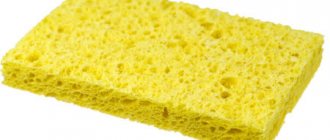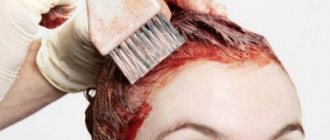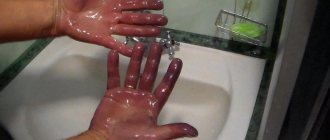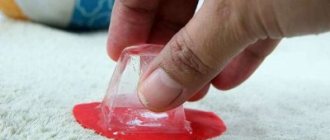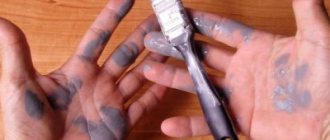The question of how to remove henna from the skin is relevant for women who use natural dye to dye their hair, eyebrows or apply a temporary tattoo - mehendi. Once on the skin, the pigment quickly penetrates the dermis and is eaten away, so it is impossible to wash it off with water and the use of additional products is required. Special cosmetics or improvised substances will help solve the problem. When choosing a pigment removal method, consider the degree and area of contamination.
Henna is a natural dye that has a wide range of applications. Sometimes a mistake happens, the pigment stains the skin and in order to return the skin to purity, the use of additional products is required
The article contains the most effective means and methods by which you can wash out the dye and also prevent skin staining. However, it is not enough to know popular methods; it is important to be able to use each of them correctly and follow the recommended safety measures.
Features of washing off henna from the skin of the face, eyebrows, arms and shoulders
The process of removing red pigment has its own characteristics.
This dye is capable of entering into a chemical reaction with other substances, so as a result of trying to remove a stain with an inappropriate product, it may not only not lighten, but also become brighter.
Any oil can be used for cleaning, only sea buckthorn oil is not suitable
The final result of the procedure depends on strict adherence to the recommendations:
- Vinegar and lemon juice should not be used in their pure form for cleansing, as they are used to fix the design. These substances can only be used in combination with other ingredients.
- Before applying the cleansing product, you should steam the problem area, which will improve access to the pigment.
- You shouldn’t expect that after the first time the tone will completely even out. Over time, the paint eats deeply, so you should be patient and act.
- Alcohol-containing lotions for removing mehendi significantly dry out the skin. After the procedure, the residues should be thoroughly washed off under running warm water and the skin should be treated with a rich cream.
- If the substance used does not bring a positive result, you need to try another only after a day, so that the epidermis has time to recover.
- To remove mehendi from the face, you need to select gentle solutions, as there is a risk of drops getting into your eyes.
Advice! After cleansing, apply a moisturizer to the skin to restore its ability to regenerate.
Home remedies for removing henna
You can get rid of red traces of natural dye using improvised means that are in the kitchen, medicine cabinet or bathroom of every housewife. We have collected the most effective methods that are effective and safe.
Vinegar solution
A vinegar solution will help to wash off the coloring pigment. To prepare it, combine water and vinegar in equal proportions and mix well. Treat the contaminated area with the resulting liquid, and then rinse with warm water.
Do not use vinegar in its pure form, as it will enhance the effect of the henna, make it brighter, and may also cause irritation.
Lemon juice and soda
Citrus juice has a whitening effect, and soda acts as an abrasive, so this tandem produces quick and effective results. Application procedure:
- Mix lemon juice, water and baking soda to make a paste.
- Apply the composition to the dirty area and leave for a few minutes, then rub in with massage movements.
- Rinse off the mixture with warm water.
- If necessary, repeat the procedure after 24 hours.
Lemon juice is effective in cleansing henna only in combination with other substances, since in its pure form it has the opposite effect - it promotes stronger fixation of the pigment
Citrus is a fairly strong allergen, so before using the mixture, do a test on a small area: apply the composition to the skin and let it remain on it for 15 minutes, and then rinse with warm water. If there is no redness or rashes, you can use this product to remove pigment.
Oils
Vegetable or cosmetic oil will help to remove henna from the skin at home. Application procedure:
- Heat a small amount of vegetable oil in a water bath.
- Apply the product to the skin using a cotton swab.
- Wrap the dirty area in cling film or wear gloves.
- After half an hour, wash the cleaned area with warm water and soap.
Olive or other vegetable oil will help remove traces of natural dye. To enhance the result, the product can be slightly heated or a greenhouse effect can be created.
A mixture of cognac and olive oil will help remove dirt. Apply the composition to the stain and wrap it with polyethylene. After an hour, wash your hands with running water and soap.
Alcohol-containing products
Alcohol, vodka or other alcohol-containing liquid will help remove henna stains. To carry out the procedure, soak a cotton pad in the selected product and wipe the stained area. After completely cleansing the skin, rinse the treated area with warm water.
Pumice
Mechanical action will help wash your hands. To carry out the procedure, steam the skin well in warm water and then rub with a pumice stone. Avoid strong pressure to avoid damaging the dermis.
To remove henna, it is strictly forbidden to use kerosene, gasoline, acetone, washing powder, or substances intended for household surfaces.
Recipes for masks for removing henna from hair
The pigment is difficult to remove not only from the skin, but also from the hair. Before using the dye, you should prepare a wash in advance, since the remaining pigment can be quickly removed only during the first two days.
Before using the dye, you should prepare a wash in advance, since pigment residues can be quickly removed only during the first two days
In the future, it will be more difficult to cope with this task.
Effective mask recipes for restoring hair color after unsuccessful dyeing:
- Burr oil. You need to slightly heat the component and distribute it over the entire length of your hair. Wrap the top of your head with film, then wrap it with a towel. After 40 min. wash off. The mask allows you not only to improve the shade, but also to restore the damaged structure of the curls.
- Sour cream. To lighten the tone and smooth out the red color, distribute the fermented milk product along the entire length of the hair. Leave for 1 hour. Wash off any remaining residue with shampoo.
- Kefir and yeast. Mix the mask ingredients in a 4:1 ratio. Distribute the resulting mass over the colored curls and leave for 2 hours. When finished, wash your hair with shampoo.
- Vodka, olive oil, honey. All alcohol-containing liquids help open the hair scales, which allows you to neutralize the pigment in the deep layers. Combine 70 ml of vodka, 50 ml of olive oil and 30 ml of honey. Heat the mixture to a comfortable temperature. Distribute the mask over the entire length and leave for 2 hours. After time, rinse thoroughly.
- Yeast and sugar . Combine 1 package of dry yeast with 20 g of sugar. Add 80 ml of water to the dry mixture. Stir until completely dissolved. Leave the mixture to infuse for half an hour, then distribute over the entire length of the hair. Cover your head with film and wrap it in a towel. After 1 hour, wash off.
- Laundry soap. To wash out the pigment, you need to soap your hair generously and massage it. Wash your hair, apply a nourishing mask. Repeat the process every other day.
Read more ► How to remove nail polish from clothes: quick and effective ways to remove stains
Removing mehendi
Henna tattoos, so-called mehendi, are now very popular. They are applied to the palms, feet, even to the back and lower back. But what if you don’t like the drawing, are tired of it, or have partially washed away and now look ugly? There are several ways to remove henna.
- If the image has just been applied and the dye has not yet been absorbed, you should wash the area with warm running water, always using laundry soap.
- However, if time is lost and the henna has already dried, this method will not help; more radical solutions will be required. First of all, you should wipe the stained area with a cotton pad generously soaked in vodka, alcohol solution or medical alcohol.
After this treatment, the painted area is washed with soap and water and lubricated with a rich cream.
If mehendi has been on the body for several days and suddenly there is a need to remove the pattern, you can use the following methods.
- Warm bath. After sitting in the bath for a while to allow the skin to steam, the area with the tattoo should be thoroughly treated with a washcloth or belongings and rubbed vigorously. The procedure will make the pattern less noticeable; the henna will completely disappear after several times. You can clean the painted area using pumice, but this method cannot be called gentle - the upper layer of the epidermis will suffer. However, the dye will wash off quite well.
- Salt bath. If the design is applied to brushes, it can be washed using salt baths. To do this, dissolve 2 tbsp in a small bowl of water. l. sea salt, place the brushes and wait until the water cools down. The pattern will become less noticeable.
- Salt mask. You can also remove henna from the skin using salt masks. This is done if the baths are uncomfortable - for example, when the pattern is located on the back. Making them is simple: moisten an old towel with saline solution (2 tbsp per liter), place it on the area with the pattern, wrap it with cling film and wait for at least half an hour, then rinse with water.
- A small mark or trace of henna can be washed off with antibacterial soap applied to a toothbrush. It is necessary to rub the stained area intensively and then rinse with water.
We recommend: Laundry sheets - newfangled nonsense or a really good product?
Some of the methods that allow you to remove traces of henna will be effective after several procedures.
How to prevent staining
When using henna, you should remember that it is better to prevent skin staining than to deal with the consequences. By following simple rules, you can prevent the appearance of red spots.
Basic steps to help avoid staining:
- the dyeing procedure should be carried out with gloves, which will help prevent pigmentation of the hands;
- you can apply a wide strip of rich cream along the hairline, which will prevent the pigment from penetrating into the deep layers of the epidermis;
- melt the beeswax to a liquid consistency and treat the areas adjacent to the hair (as the wax hardens, a protective film is formed).
Advice! If you use henna, always have a damp sponge or pad on hand. This will allow you to wipe away any drops that get on your skin at any time.
Cosmetic methods
There are several other options to remove reddish spots from your skin.
- Lotions containing alcohol allow you to quickly get rid of traces of henna.
- Using nail polish remover is another effective way to remove stains. However, it is not recommended for use on the face.
- The scrub makes it possible not to completely cleanse the skin, but to make the red color a little lighter. It can be used in cases where the skin is very sensitive and prone to irritation from interaction with alcohol-containing substances. It is necessary to take a small amount of scrub and treat the painted areas.
- Sea salt. Acts on the principle of a scrub, removing paint along with skin cells. This method is not suitable for those who have inflammation or acne on their face.
Advice
Any of the listed products has a negative effect on the condition of the skin, so after treatment you should thoroughly rinse the painted area with water and then apply a greasy cream to it. For the face, it is best to make a nourishing mask.
What not to use to remove henna from skin
To remove traces of a blurred tattoo or other stains, do not use aggressive components. The use of these substances will help remove pigment, but can cause burns, inflammation and skin pathologies.
Prohibited components:
- acetone;
- kerosene;
- petrol;
- bleaches;
- washing powder;
- cleaning products for glass and other surfaces.
If henna stains appear on the nail plates, then nail polish remover should be used with caution.
Aggressive components must not be used on the face, since any careless movement can lead to the substance getting into the eyes, which can lead to serious complications.
Radical methods of washing henna
It is quite difficult to wash henna off your hands, so it is recommended to use more radical and aggressive methods. They should absolutely not be used on the face due to the high risk of irritation, rashes or dry skin. These methods should be used in exceptional cases when safer and more gentle methods have not had the desired effect.
To easily remove a henna tattoo from your hands, use hydrogen peroxide or ammonia: wipe the contaminated area with a cotton pad soaked in the chosen product, and then rinse with plenty of water. When processing, move from the edges of the stain to the center to avoid increasing its area.
You can remove natural dye from your hands yourself at home, using folk or cosmetic products
A strong solution will help remove the stain:
- Combine 1 tbsp. l. ammonia, 5 tbsp. l. hydrogen peroxide and water.
- Apply the resulting mixture to the stain with a cotton pad and leave for 10 minutes.
- Rinse off the solution and dirt with warm water, and then use a rich cream.
You can erase traces of henna from the skin using folk or cosmetic products, as well as through mechanical action. To avoid having to consider options for removing stains, take care of protecting the dermis in advance: wear gloves, try to dye your hair or skin as carefully as possible, and generously lubricate the area around with greasy cream or Vaseline.
Additional methods
Henna is not easy to wash off, so you need to be prepared for the fact that you will have to use various methods.
- You can use vegetable oil heated in a steam bath. Using a swab, apply the oil to the painted area, then wrap it with cling film (if there are traces of henna on your palms, you can wear rubber gloves) and leave for 30 minutes. After this, the skin is washed with water and soap.
- Olive oil is mixed with cognac (for a small area, you can take 2 tablespoons of both), the mixture is applied to the skin, left to act for an hour, and washed.
Advice
Experts recommend using laundry soap in the last two cases; it allows you to quickly remove paint residues.
- Tooth powder helps remove even the most stubborn dye without damaging the skin of your hands. It is applied using an old toothbrush, rubbed vigorously, then removed. Palms must be wet before processing.
These methods will help remove henna from the skin, but you should not expect a quick effect; the procedures will have to be repeated several times.
Reasons for flushing
Henna is washed off when an undesirable shade appears. This is difficult to do even for a qualified hairdresser. If the composition is used incorrectly, the hair acquires a blue or green tint. After natural dye, it is impossible to obtain the desired hair color with chemical dyeing, so it is recommended to remove henna.
If a woman has a desire to completely change her image and haircut, then henna removal is first carried out. She is able to stay on the strands for a long time. If you apply ammonia paints on top, this will lead to an undesirable shade.
What not to do
Wanting to get rid of reddish spots as quickly as possible, some begin to use all available means. However, it is important to know that the following substances cannot be used to remove henna from the skin:
- petrol;
- washing powder;
- acetone;
- solvent;
- wiper.
They are toxic and will have a very negative impact on the condition of the epidermis, so they should not be used.
Removing henna from the skin is quite problematic, but home methods allow you to do this, albeit with some effort. The main thing is not to use all the means at once.
Precautionary measures
You can insure against troubles when removing traces of paint from the eyebrows, face, neck or removing mehendi by following the recommendations. To avoid or minimize adverse effects, the following safety precautions must be followed:
- Before applying the paint, a skin reaction test to the dye is carried out;
- the procedure is performed with gloves;
- After cleansing the skin, use a protective cream;
- The paint is washed off immediately after contact with the skin.
To ensure that the skin has less contact with the dye, it is recommended to lubricate it with rich cream or baby soap. Natural henna attracts many women. It pleases not only with its bright color and beneficial properties for hair, but also with the quick washing away of traces from skin areas.
Source
Henna drawing
This tattoo technique is called mehendi. The designs are made with special hypoallergenic henna; they can be a classic red color or have a wide color palette. Images are applied to any part of the body at the request of the client. Such tattoos are especially in demand in the summer. Their advantages are that they are done painlessly and for a short period of time. There is always the opportunity to delete the drawing completely or make another one.
The holding time of mehendi on the skin is approximately 2 weeks, but depending on the area of application, these periods may vary. Images are erased faster if they are located on the folds, on the wrists, where they often come into contact with water. Also, their rapid erasure occurs from intensive rubbing with a washcloth.
A luxurious figure without the gym!
Fitness expanders will allow you to organize a complete and effective workout both at home and on the street. You can achieve the desired result by doing just 20 minutes a day! Suitable for both beginners and trainers!
MORE >>
The problem is that the pattern wears off gradually and unevenly; after 10 days of application, unclear and unaesthetic outlines remain on the skin. I would like to remove them.
How to do it?
Do you want to regain sensitivity after childbirth? There is a simple remedy... Click here >
